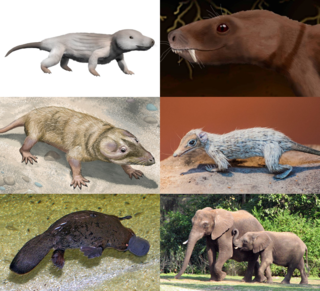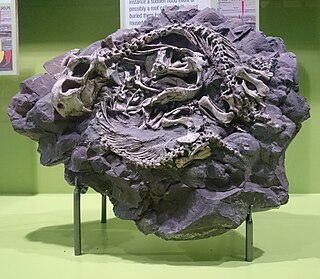Related Research Articles

Therapsida is a major group of eupelycosaurian synapsids that includes mammals, their ancestors and relatives. Many of the traits today seen as unique to mammals had their origin within early therapsids, including limbs that were oriented more underneath the body, as opposed to the sprawling posture of many reptiles and salamanders.

Cynodonts are eutheriodont therapsids belonging to the clade Cynodontia that first appeared in the Late Permian, and extensively diversified after the Permian–Triassic extinction event. Cynodonts occupied a variety of ecological niches, both as carnivores and as herbivores. Mammals are cynodonts, as are their extinct ancestors and close relatives (Mammaliaformes), having evolved from advanced probainognathian cynodonts during the Late Triassic. All other cynodont lines went extinct, with the last known non-mammaliaform cynodont group, the Tritylodontidae, having its youngest records in the Early Cretaceous.

Sauropsida is a clade of amniotes, broadly equivalent to the class Reptilia, though typically used in a broader sense to include extinct stem-group relatives of modern reptiles. The most popular definition states that Sauropsida is the sister taxon to Synapsida, the other clade of amniotes which includes mammals as its only modern representatives. Although early synapsids have historically been referred to as "mammal-like reptiles", all synapsids are more closely related to mammals than to any modern reptile. Sauropsids, on the other hand, include all amniotes more closely related to modern reptiles than to mammals. This includes Aves (birds), which are now recognized as a subgroup of archosaurian reptiles despite originally being named as a separate class in Linnaean taxonomy.

Dicynodontia is an extinct clade of anomodonts, an extinct type of non-mammalian therapsid. Dicynodonts were herbivores that typically bore a pair of tusks, hence their name, which means 'two dog tooth'. Members of the group possessed a horny, typically toothless beak, unique amongst all synapsids. Dicynodonts first appeared in Southern Pangaea during the mid-Permian, ca. 270–260 million years ago, and became globally distributed and the dominant herbivorous animals in the Late Permian, ca. 260–252 Mya. They were devastated by the end-Permian Extinction that wiped out most other therapsids ca. 252 Mya. They rebounded during the Triassic but died out towards the end of that period. They were the most successful and diverse of the non-mammalian therapsids, with over 70 genera known, varying from rat-sized burrowers to elephant-sized browsers.

Biarmosuchia is an extinct clade of non-mammalian synapsids from the Permian. Biarmosuchians are the most basal group of the therapsids. They were moderately-sized, lightly built carnivores, intermediate in form between basal sphenacodont "pelycosaurs" and more advanced therapsids. Biarmosuchians were rare components of Permian ecosystems, and the majority of species belong to the clade Burnetiamorpha, which are characterized by elaborate cranial ornamentation.

Therocephalia is an extinct clade of eutheriodont therapsids from the Permian and Triassic. The therocephalians ("beast-heads") are named after their large skulls, which, along with the structure of their teeth, suggest that they were carnivores. Like other non-mammalian synapsids, therocephalians were once described as "mammal-like reptiles". Therocephalia is the group most closely related to the cynodonts, which gave rise to the mammals. This relationship takes evidence in a variety of skeletal features.

Anteosaurus is an extinct genus of large carnivorous dinocephalian synapsid. It lived at the end of the Guadalupian during the Capitanian stage, about 265 to 260 million years ago in what is now South Africa. It is mainly known by cranial remains and few postcranial bones. With its skull reaching 80–90 cm (31–35 in) in length and a body size estimated at more than 5 m (16 ft) in length, and 500 to 600 kg in weight, Anteosaurus was the largest known carnivorous non-mammalian synapsid and the largest terrestrial predator of the Permian period. Occupying the top of the food chain in the Middle Permian, its skull, jaws and teeth show adaptations to capture large prey like the giants titanosuchids and tapinocephalids dinocephalians and large pareiasaurs.

The Eodicynodon Assemblage Zone is a tetrapod assemblage zone or biozone which correlates to the Abrahamskraal Formation, Adelaide Subgroup of the Beaufort Group, a fossiliferous and geologically important geological Group of the Karoo Supergroup in South Africa. The thickest outcrops, reaching approximately 620 metres (2,030 ft), occur south-east of Sutherland, north of Prince Albert, and south-east of Beaufort West. The Eodicynodon Assemblage Zone is the lowermost biozone of the Beaufort Group.
Paleontology or palaeontology is the study of prehistoric life forms on Earth through the examination of plant and animal fossils. This includes the study of body fossils, tracks (ichnites), burrows, cast-off parts, fossilised feces (coprolites), palynomorphs and chemical residues. Because humans have encountered fossils for millennia, paleontology has a long history both before and after becoming formalized as a science. This article records significant discoveries and events related to paleontology that occurred or were published in the year 2003.

Eodicynodon is an extinct genus of dicynodont therapsids, a highly diverse group of herbivorous synapsids that were widespread during the middle-late Permian and early Triassic. As its name suggests, Eodicynodon is the oldest and most primitive dicynodont yet identified, ranging from the middle to late Permian and possessing a mix of ancestral Anomodont/therapsid features and derived dicynodont synapomorphies.

Daptocephalus is an extinct genus of non-mammalian synapsid anomodont dicynodont, it which was found in Late Permian strata, in a biozone known precisely for the presence of fossils of this dicynodont, the Daptocephalus Zone, in the Karoo Basin in South Africa. An additional species, D. huenei, is known from the Usili Formation in Tanzania and was formerly assigned to the genus Dicynodon before a study in 2019 recognised that the type specimen belonged to Daptocephalus.
Elliotsmithia is a small varanopid synapsid found from the late Middle Permian of South Africa. It is the sole basal synapsid "pelycosaur" known from the supercontinent Gondwana and only two specimens have been yielded to date. Its species name longiceps is derived from Latin, meaning "long head". Both known Elliotsmithia fossils were recovered from Abrahamskraal Formation rocks—within the boundaries of the Tapinocephalus Assemblage Zone—of the lower Beaufort Group. It was named for the late Sir Grafton Elliot Smith in 1937.

Ictidorhinus is an extinct genus of biarmosuchian therapsids. Fossils have been found from the Dicynodon Assemblage Zone of the Beaufort Group in the Karoo Basin, South Africa and are of Late Permian age. It had a short snout and proportionally large orbits. These characteristics may be representative of a juvenile animal, possibly of Lycaenodon. However, these two genera are not known to have existed at the same time, making it unlikely for Ictidorhinus material to be from a juvenile form of Lycaenodon.
Koupia is a dubious extinct genus of non-mammalian synapsid. The type species, K. koupensis, was coined by Lieuwe Dirk Boonstra in 1948, with a well-preserved skull from the Tapinocephalus Assemblage Zone of South Africa, SAM-PK-11796, designated the holotype. This specimen has since been lost, and K. koupensis is currently considered a nomen dubium or a possible junior synonym of Brachyprosopus broomi.

Herpetoskylax is an extinct genus of biarmosuchians which existed in South Africa. The type species is Herpetoskylax hopsoni. It lived in the Late Permian Period.

Venyukovioidea is an infraorder of anomodont therapsids related to dicynodonts from the Permian of Russia. They have also been known as 'Venjukovioidea', as well as by the similar names 'Venyukoviamorpha' or 'Venjukoviamorpha' in literature. This in part owes to a misspelling by Russian palaeontologist Ivan Efremov in 1940 when he mistakenly spelt Venyukovia, the namesake of the group, with a 'j' instead of a 'y', which permeated through subsequent therapsid literature before the mistake was caught and corrected. The order Ulemicia has also been coined for a similar taxonomic concept in Russian scientific literature, which notably excludes Suminia and Parasuminia.

Chainosauria is a large and speciose clade of anomodont therapsid that includes the highly diverse dicynodonts and a small number of closely related basal genera —although the total composition and taxonomic scope of Chainosauria is in flux. Chainosauria was named in 1923 to group together the dicynodonts and their close relatives, namely three small anomodont genera from South Africa that made up the now defunct group 'Dromasauria'. The name soon fell into disuse, however, as it was functionally replaced by Anomodontia. Chainosauria was later revived cladistically in 2009, preserving the association of dicynodonts and the 'dromasaurs' and has since served in effect as both a cladistic and a biogeographic counterpart to the Laurasian venyukovioids, with early chainosaurs appearing to have been a Gondwanan radiation.

The Abrahamskraal Formation is a geological formation and is found in numerous localities in the Northern Cape, Western Cape, and the Eastern Cape of South Africa. It is the lowermost formation of the Adelaide Subgroup of the Beaufort Group, a major geological group that forms part of the greater Karoo Supergroup. It represents the first fully terrestrial geological deposits of the Karoo Basin. Outcrops of the Abrahamskraal Formation are found from the small town Middelpos in its westernmost localities, then around Sutherland, the Moordenaarskaroo north of Laingsburg, Williston, Fraserburg, Leeu-Gamka, Loxton, and Victoria West in the Western Cape and Northern Cape. In the Eastern Cape outcrops are known from Rietbron, north of Klipplaat and Grahamstown, and also southwest of East London.

Anomocephaloidea is a clade of basal anomodont therapsids related to the dicynodonts known from what is now South Africa and Brazil during the Middle Permian. It includes only two species, Anomocephalus africanus from the Karoo Basin of South Africa and Tiarajudens eccentricus from the Paraná Basin of Brazil. Anomocephaloidea was named in 2011 with the discovery of Tiarajudens, although Anomocephalus itself has been known since 1999.
References
- ↑ Lanthanostegus in the Paleobiology Database
- ↑ J. Fröbisch and R. R. Reisz. 2011. The postcranial anatomy of Suminia getmanovi (Synapsida: Anomodontia), the earliest known arboreal tetrapod. Zoological Journal of the Linnean Society 162:661-698
- ↑ S. P. Modesto, B. S. Rubidge, and J. Welman. 2003. Erratum: A replacement name for Lanthanocephalus Modesto, Rubidge and Welman 2002, not Lanthanocephalus Williams and Starmer 2000. Canadian Journal of Earth Sciences 40(3):467





